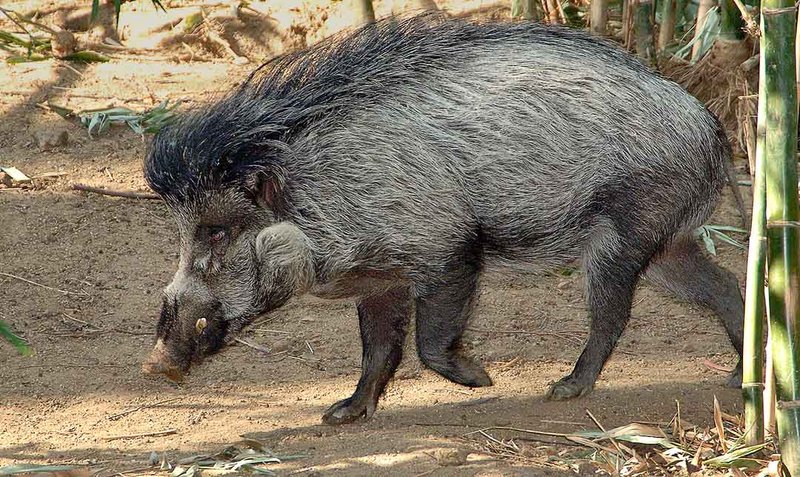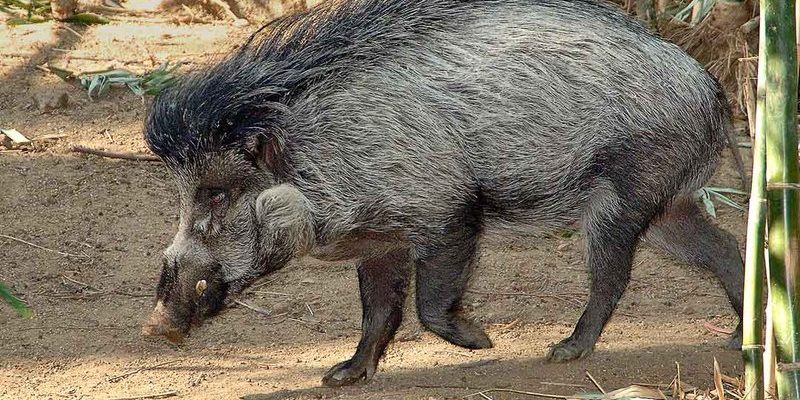
So, where does this quirky pig call home? The Visayan warty pig is native to the Philippines, specifically the Visayan Islands. Imagine a lush, green paradise filled with towering trees, vibrant flowers, and, of course, the occasional sound of a warty pig snuffling around in the underbrush. But these enchanting habitats are rapidly disappearing. Let’s dive deeper into their world and explore their living conditions, distribution, and what that means for their future.
Natural Habitat of the Visayan Warty Pig
To understand where Visayan warty pigs live, it helps to look at their typical habitat. These pigs thrive in dense forests, particularly in primary and secondary growth areas. Think of these forests as their cozy living rooms, filled with all the food and shelter they need. The thick foliage provides safety from predators and a bounty of roots, fruits, and vegetation for them to munch on.
The warty pig has adapted well to its environment. They’re not just typical forest dwellers; they’re also comfortable in grasslands and agricultural areas nearby. This flexibility helps them survive in changing conditions. Here’s the thing: while they can roam into farming areas, it’s often a risky venture, as human activities pose significant threats.
In terms of geography, the Visayan warty pig primarily inhabits the islands of Negros, Panay, and Cebu. Unfortunately, due to habitat destruction and hunting, their range is shrinking. So, if we think of their habitat like a puzzle, each piece is disappearing piece by piece.
Distribution Across the Visayan Islands
Now that we’ve painted a picture of their habitat, let’s explore the specific distribution of the Visayan warty pig. As mentioned earlier, these pigs are found mainly on the islands of Negros, Panay, and Cebu, all of which are part of the central Philippines. However, they don’t occupy the islands evenly. Each island has populations in different areas, largely depending on the availability of their preferred habitats.
On Negros Island, for example, some populations are protected in conservation areas, while others are more exposed to human encroachment. This means that, like any good treasure map, knowing where to find these pigs is essential for conservation efforts. Each island showcases different challenges, from deforestation to hunting, threatening the pig’s livelihood in these regions.
While they once roamed wider, these pigs have become confined to smaller regions due to habitat loss. You might be wondering just how small these populations have shrunk. Estimates suggest that only a few hundred remain in the wild, which is alarming. Conservationists are trying to keep track of their distribution so we can better protect these unique animals.
Threats to Their Habitat
The Visayan warty pig’s habitat isn’t just picturesque; it’s also under serious threat. One major issue is **deforestation**. As logging and agriculture continue to expand, these pigs lose their homes. Imagine if someone suddenly took over your cozy nook—you’d be pretty upset, right? That’s exactly how these pigs feel when their forests get chopped down.
Another threat is **hunting**. While they’re not typically hunted for food, they can be captured for the exotic pet trade or as trophies. This creates more pressure on an already dwindling population. If more people understood these pigs’ precarious situation, we might see less poaching and more conservation efforts.
To make matters worse, the **fragmentation** of their habitat means that even where they can live, their populations are often isolated. This isolation can lead to inbreeding and weak genetic diversity, which isn’t ideal for any species. In essence, while they’re still hanging on, they’re like a delicate flower trying to survive in a garden full of weeds.
Conservation Efforts and Protected Areas
Given the threats, you might be curious about what’s being done to protect the Visayan warty pig. Conservationists are actively working to create protected areas where these pigs can roam freely and safely. These sanctuaries are like safe havens, allowing the pigs to thrive without the constant threat of human interference.
In addition to protected areas, organizations are also working on **habitat restoration**. This means replanting trees and restoring the forest, which is critical for these pigs. Imagine trying to host a party in a room with half the furniture missing. Restoration efforts aim to fill the gaps, providing a better space for the warty pigs to live.
Education plays a crucial role, too. By raising awareness about the significance of the Visayan warty pig, more people can contribute to its preservation. Whether it’s through community initiatives or global campaigns, every little bit helps. The more we understand these pigs, the more likely we are to protect their homes.
The Role of Local Communities
Local communities are essential in protecting the Visayan warty pig. These are the people who share the landscape with these unique creatures. When communities are involved, conservation efforts can be much more effective. Think of it like a team effort; everyone has a role to play in protecting this special animal.
One way local people can help is by promoting **sustainable practices**. By farming in a way that minimizes impact on the forests, they’re helping to create a balance between their needs and the needs of the pigs. This is crucial because when communities prosper, they’re less likely to encroach on the pigs’ habitats.
Additionally, educational programs can empower locals to become advocates for conservation. When people learn about the value of biodiversity—how each species contributes to the ecosystem—they’re more likely to support efforts to protect it. It’s a win-win situation that benefits both the pigs and the people.
The Future of the Visayan Warty Pig
So, what does the future hold for the Visayan warty pig? Honestly, it’s a mixed bag. On one hand, there’s hope due to increasing conservation efforts, but on the other, the threats remain daunting. The survival of this species depends largely on balancing human needs with wildlife conservation.
If we continue to support conservation efforts and understand the importance of habitats, there’s a chance we can help these pigs thrive. Remember, every small action counts, whether it’s supporting local conservation initiatives or simply spreading the word about the Visayan warty pig.
In the end, these unique pigs need our help to survive. As more people become aware of their situation, we can work together to ensure that future generations get to admire the Visayan warty pig in its lush, natural habitat. It’s about preserving a little bit of magic in our world, one warty pig at a time.

